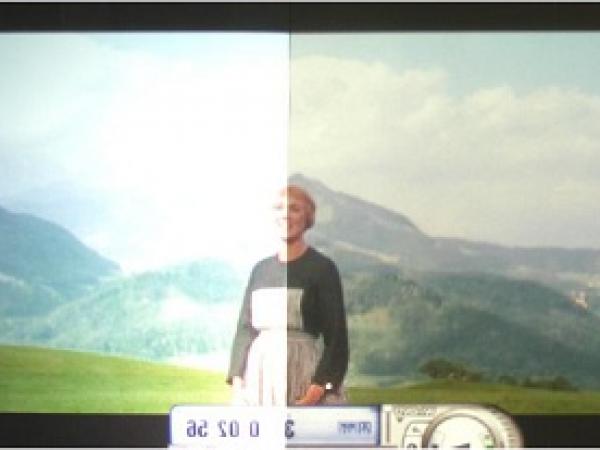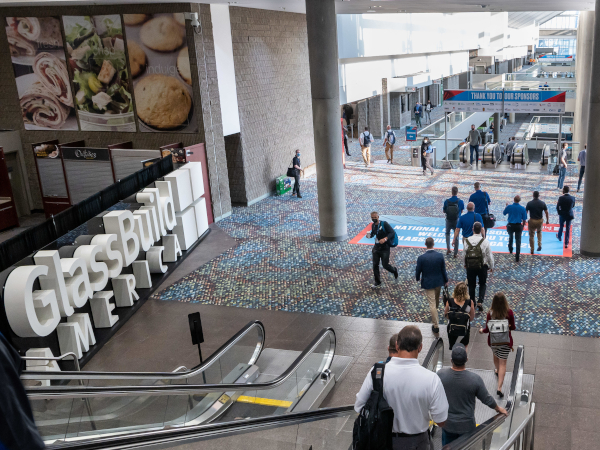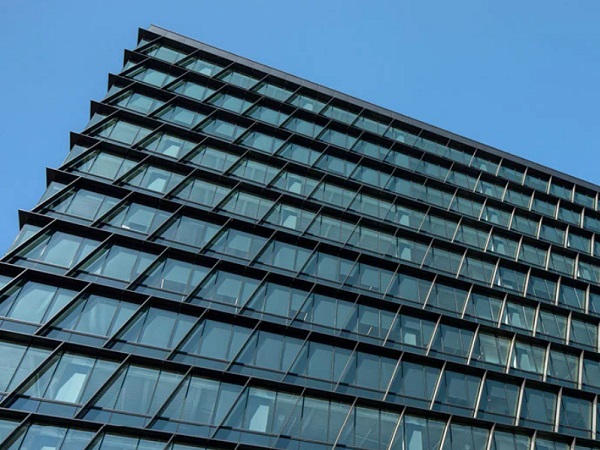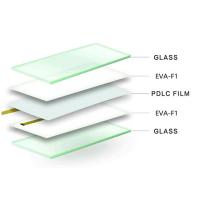These requirements automatically form an industrial guideline for evaluating quality of LC films. It is easy to understand a haze at clear state to be as transparent as possible. But there may be many questions for opaque state.
1. Properties of Scattering
In various applications of liquid crystal (LC) films, people always want the lowest haze at clear state and the highest opacity or scattering at opaque state. These requirements automatically form an industrial guideline for evaluating quality of LC films. It is easy to understand a haze at clear state to be as transparent as possible. But there may be many questions for opaque state. What is characteristic of scattering?
How to evaluate scattering? What kind of standard can be used? To answer these questions, it is better to first review scattering properties in optical physics. Figure 1 to Figure 4 illustrate different levels of scattering. In these figures, vertical lines represent scattering surfaces, such as testing samples, and arrows in right side represent incident lights.
.jpg)
Figure 1 shows a situation, in which incident light passes through a clear sample, such as glass or film, without scattering. Figure 2 shows a situation, in which a sample just has a little scattering like a case of beginning stage of grinding a clear glass to form a frosted glass. An oval shape represents intensity of scattered light in all directions. Figure 3 shows a low level of scattering like a frosted glass.
First generation (1G) and second generation (2G) LC films are close to this situation. Such scattering has following characteristics. (1) Intensities of scattered lights in all directions form an oval shape, so called oval scattering. This oval shape also represents a distribution of brightness. (2) Intensities of back scattering (back to incident direction) are much weaker than transmitted intensities. (3) Transmitted energy still remains a major direction same as incident direction. It is the characteristics that seriously affect quality of projection.
Figure 4 shows a high level of scattering, in which scattering lights have same intensities in all directions and form a sphere, so called spherical scattering. Scienstry’s 3G Switchable FilmTM has such scattering. Spherical scattering equally distributes scattered lights in both sides of scattering surface and does not have a major direction. It is symmetrical and uniform in all directions. Such optical properties are very good for projection and have a lot of advantages in various applications.
2. How to Evaluate Scattering
Scattering capability can be easily evaluated by utilizing “Hidden Power”. Following pictures show an actual testing situation. Three generations of LC films are placed side by side to review their hidden powers. Picture 2 is taken in vertical view. Picture 1 and Picture 3 are in tilted views. The films are placed above table surface for about 3 centimeters (or 1.1 inch) with a colorful background. As shown in the pictures, 3G Film can totally hide all colors in any angle. Background colors are still seen through 1G and 2G films.
However, hidden power of 1G film is even weaker than 2G film at room temperature. This method is very useful to quickly evaluate different LC films without an optical instrument. The background may be anything like newspaper, magazine, book or hand. Scienstry encourages all users to conduct such test in selecting LC films. Since projection quality is totally depended on scattering capability, the differences in hidden powers will greatly affect results for projection.
.jpg)
Picture 1
.jpg)
Picture 2
.jpg)
Picture 3
Since older generations of LC films have a serious oval effect and their scattered lights are not symmetrical to the scattering surface, such films have no or poor projection capability. Such films cannot be used for front projection, because beck scattering is too weak. When such films are barely used for rear projection, non-uniformity problem may show up. Picture 4 and picture 5 show comparison of uniformity of brightness for rear projection between older film and 3G Film.
A projector is placed behind and at middle of two different films. Left image in each picture is on old generations of LC films and shows bright zone or "lunar halo" problem. Right image in each picture is on 3G Film and shows a great uniformity of brightness. In projection field, a screen is not considered as a good screen if the difference of brightness is beyond 10%.
.jpg)
Picture 4
.jpg)
Picture 5
3. What Advantages Does A Non-linear 3G System Have?
3G Switchable FilmTM has spherical scattering. That is why that 3G Switchable Film have a great uniformity in both side and can do both front and rear projections. How does 3G Film achieve spherical scattering? This may be everyone’s next question. It is not easy to achieve such capability in projection field. This is first time to have a projection screen with a perfect scattering.
To achieve such effect, non-linear optics plays an important role. Non-linear optics includes a characteristic of gradually changed reflection indexes. Scienstry first introduce non-linear optics and materials into LCD field. As we know, classical optics has been studied hundreds of years. In our daily life, we experience various optical materials and properties. We use water, glass or clear plastics or cameras and are familiar with light transmit and reflection.
These optical behaviors are belonged to classic optics which is based on a straight pathway of light. Non-linear optics is a very young scientific field formed around 1990s. Most interested behavior of non-linear optics is its curved pathway. When Albert Einstein predicted that a light may be bent by sun’s gravity, it surprised many scientists. Many years later, when non-linear optics is used in LCD field, it also brought a lot of surprised results. It may improve many optical applications.
Figure 5 illustrates scattering mechanism of 3G Film with non-linear optical materials, where circles represent droplets of liquid crystals. In micro structure as illustrated for 3G Film, liquid crystal micro droplets are dispersed in a non-linear polymer matrix, which allows a light travel in curved way within the matrix. Although incident light A and light B come from same direction, there are chances for a droplet to receive the incident lights from all directions including opposite directions.
The non-linear optics promotes formation of spherical scattering. If one time or one layer of such scattering is not enough to produce a perfect uniformity, and then add more layers. In order to achieve a super uniformity, 3G Film is consisted of 50 layers of nano droplets in its micro structure. When a light is able to travel in curved way in a media, many traditional features like incident angle or viewing angle lose their meanings, because the incident light can reach to any point from any direction. Therefore, as the outputs, scattered lights can be in all directions. That forms a spherical scattering.
.jpg)
Figure 5
3G Switchable FilmTM not only is sole liquid crystal (LC) film which can do both front and rear projection, but also has a special feature of Viewing Angle Independent (VAI) brightness or same brightness in 360°. Only 3G Film has such special projection capability in the market.
Figure 4 illustrates an ideal situation, in which incident light comes from any angle to any point on a scattering surface, the light spot will do a spherical scattering. Scattered light will be equally distributed at any angle as well as in both sides of the sample. A great brightness uniformity on 3G Switchable FilmTM can be proven by video images, click here to watch a video proof of same brightness in 360 degree, and video-2.
By reviewing these figures from Figure 1 to Figure 5, we may understand that an oval shape indicates scattering capability. The flatter an oval shape, the weaker scattering capability is, corresponding to a weak opacity or hidden power too. When scattering gets stronger, oval shape becomes more round. Since view blocking capability of liquid crystal film is totally depended on scattering levels as we experienced, scattering capability is naturally used to evaluate quality of LC film.
A non-uniform scattering never offers a good result for projection. According to law of conservation of energy, the better scattering a sample has, the weaker transmitted light along with incident direction should be. When all directions of lights have maximum energy, only result is that light intensity along the incident direction is equal to intensities of other directions; therefore, a spherical scattering is formed.
Since front projection mainly utilizes back scattering capability, picture quality is depended on back scattering capability. Spherical scattering brings more light back to incident side than oval scattering, so spherical scattering has a great brightness. That is why older films with serious oval effect are not suitable for projection, definitely not for front projection or short throw front projection.
4. Stability of Scattering
Different scattering discussed above is limited in room temperature. Actually, scattering capability is always affected by temperature. Stability of scattering is also important feature for a projection screen, especially for liquid crystal switchable projection screen. Instability of opacity will seriously affect quality of projection. Picture 6 to 9 show an actual scattering test for three generations of LC films. The test shows that temperatures can greatly affect scattering of LC films. A detail comparison among different LC films at different temperatures can be reviewed by newsletter: Haze_Comparision
.jpg)
.jpg)
In this test, three generations of LC films are placed in an oven. 3G Film is at center, 1G film at left and 2G film at right. This test shows that scattering of 3G Film is very stable from 20 °C to 80 °C (or 68 °F to 176 °F), while 1G film and 2G film quickly lose scattering at higher temperatures. As we can see an interesting phenomenon, at room temperature, scattering of 1G film is poorer than 2G film, but at higher temperature, scattering of 1G film is better than 2G film. In other words, 2G film has the worst stability of scattering and 1G film has the worst scattering in room temperature. 3G Film has both the best scattering and the best stability of scattering at the tested temperatures range.
5. Applications in Projection
As described above, spherical scattering is good for both front projection and rear projection, because it brings same light intensity in both sides of projection screen. Therefore, 3G Switchable FilmTM is suitable in most situations of projection. As we know, projection requires certain ambient lighting and space. At daytime outdoor is much brighter than indoor. For working, studying or entertainment purposes, indoor condition is better for projection. On the other hand, rear projection and front projection have different requirements for space.
Rear projection requires a separated projection distance and viewing distance, and front projection shares these distances, therefore, front projection needs relative smaller space. Due to limitations of lighting condition and room space, front projection has much more chances to be used in most non-commercial areas like homes, schools or companies. With broader suitability, 3G Switchable Film with spherical scattering feature shows great advantages in various projections.
When doing front projection, surface reflection from a projector is easy to generate a hot spot. Using a short throw projector can completely eliminate such reflection. However, most projection screens including all high contrast projection screens and older LC films do not allow using a short throw projector, and then cannot avoid such reflection. 3G Switchable FilmTM allows using a short throw projector, therefore, can easily overcome such problem.
Again spherical scattering property plays an important role in use of a short throw projector, because it does not care where incident light come from and scattered lights are always equal in all directions. Figure 6 illustrates small angle projection to 3G Film. However, if old LC films are used for short throw front projection as illustrated in Figure 7, a main light energy will waste in opposite side (left side) toward a floor and the brightness back to a viewer is too weak, because the oval shape also represents a distribution of light energy. That is a reason why older LC films cannot be used for a short throw projection.

3G Switchable FilmTM is made with 100% optical transparent materials. It totally depends on scattering to regulate lights. In the other words, it only changes directions of lights, but not absorbs any visible light. Therefore, it can completely deliver all color information provided by a projector to viewers. All other projection screens always absorb some degree of light and lose some information from a projector.
3G Switchable Film remains not only a true color, but also the best parameters for other features like screen gain and half gain angle etc. It is important to mention that due to its absolute wide viewing angle, half gain angle for 3G Film is not existed. This is a unique case in projection field.
For all existing projection screens, brightness in vertical view is always brighter than tilted view. The angle having 50% brightness in vertical view is called half gain angle. Half gain angle always fall within 90 degree. Half gain angle is an important index for projection, and reflects quality of viewing angle and uniformity of brightness.
When 3G Film allows a light travel in curved way to have same brightness at any angle, some characteristics of linear optics such as incident angle and viewing angle lose their physical meanings. Beyond 90 degree, the definition of half gain angle loses its original meaning for reflection. This unique feature could greatly impact projection field. A great effect can be seen from an application of switchable_projection_window or media window.
6. Achieving the Best in Overall Quality
In order to improve quality of projection, it is not enough to have great optical properties. Other features, related with stability for moisture, heat, UV as well as power consumption, need to be improved too. Pursuing great features in wider range could trace back to entire history of liquid crystal development.
Transparency in clear state of LC film can be easily achieved by reducing thickness of liquid crystal layer, but such treatment will also reduce opacity in opaque state. Similarly, it is easy to increase opacity by increasing thickness of liquid crystal layer, but it will also increase haze in clear state. It is difficult to create a net wider range for any feature, such as better clarity and also better opacity. It is extremely difficult to broaden many features!
Scienstry is very successful in R&D by conducting over ten thousand experiments and discovering three new chemical reactions (equivalent to physical laws in physics or equations in mathematics), and establishes the broadest ranges for eight major features:
- Best optical properties
- Low driving voltage
- Highest stability for moisture, heat and UV
- All weather applications from -30 °C to 80 °C from indoor to outdoor
- Both front and rear projections
- Super diffusion
- Saving energy and green
- Longest lifetime
A major difference of 3G Switchable FilmTM from older generations is its non-linear system. The non-linear system is an open system which allows adding new features without bothering existing features. It is very hard to make any change to close systems of older generations. That is why 3G can keep moving forward while 1G and 2G basically have no change for over two decades. Please visit http://www.scienstry.us/products.htm for more information.











